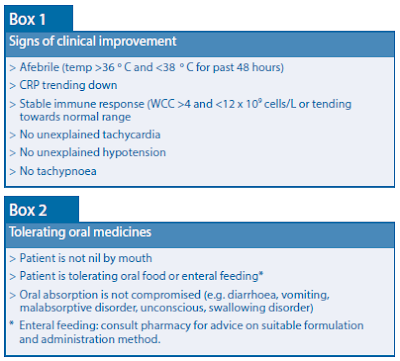- The optimal time to consider switching a patient to oral therapy is after 2 to 4 days of intravenous therapy.T
- his period of time allows the clinician to evaluate the patient’s microbiology results and assess their response to treatment.
- A large number of clinical trials support the early switching to oral antibiotics after this period of time with equal treatment efficacy and no adverse effects on patient outcome
- A patient must meet a number
of criteria prior to switching:- Display signs of clinical improvement (Box 1)
- Able to tolerate oral therapy (Box 2)
- Not have a condition in which higher concentrations of antibiotic are required in the tissue/prolonged course of IV therapy is essential(Box 4)
- There are a number of conditions in which a switch to oral therapy should be considered including:
- Pneumonia
- Skin and soft tissue infections
- Urinary tract infections
- Uncomplicated Gram negative bacteraemia
- Intra-abdominal infection without deep seated collections
References:
- Intravenous to Oral Switch Guideline for Adults Patients –can antibiotics S.T.O.P. South Australian expert Advisory Group on Antibiotic Resistance (SAAGAR)
- Focus on Converting from IV to PO Antibiotic Therapy.







Post a Comment